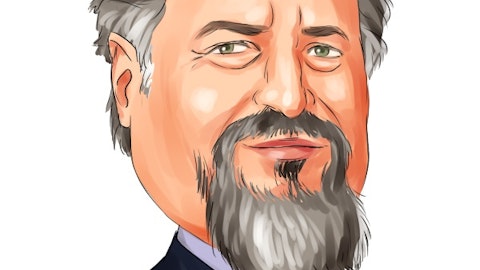Under the leadership of Jorg, the architect of Fibrinogen and Trimodulin, we will strategically strengthen innovation as our future growth engine for Biopharma. Four, we will continue to enhance donor attractiveness through personalization of the experience, digitalization and streamlining our processes. Five, we will also continue to improve our business and operations through further process optimization, streamlined operations and digitalization to drive efficiency. And sixth, as a market leader, we will explore new markets and business opportunities, but we enter into agreements to deliver groundbreaking differentiated patient and customer solutions. Importantly, these 6 strategic pillars will be backed by a performance-oriented management team and a strong people and talent development culture.
We will build on the current progress and momentum while maintaining strong financial discipline, both with regard to P&L and balance sheet management to ensure strong, sustainable long-term financials. In the coming quarters, we will give you more details of all our strategic levers and update you on the progress as we continue to deliver to our commitments in the short term. I want to conclude by reiterating how encouraged I am by all our progress in the first 9 months of the year. And I do want to thank the entire Grifols team for their hard work and dedication. I appreciate your attention, and I’ll now turn it back to Nuria, who will open it up for a discussion. Thank you.
Nuria Pascual : Thank you, Thomas, and thank you all for your time. Now let’s start the Q&A session.
A – Nuria Pascual : [Operator Instructions] First question today comes from Tom Jones from Berenberg.
Thomas Jones : Kind of both of them really relate to the tech transfer agreement that you’ve recently signed with Biotest. I wanted just a straightforward financial one really. I think you guys have this morning guided towards somewhere around a mid-triple-digit million number payments in total over the ’23, ’24, ’25, ’26 time frame. It would be helpful for us to try and understand sort of broadly how that might be weighted just to help us modulate your sort of free cash flow over the next couple of years. And then related to that, sort of related to the master distribution agreement you also have with them. Just wondering how you’re intending to position Yimmugo, that novel IVIg products against your existing Gamunex and Xembify brands and how you make sure you don’t cannibalize each other inadvertently and ultimately create the most revenue and value across the entire IgG franchise by — with all of those products?
So some idea of sort of commercial marketing strategy for those different IgG products would be helpful, I think.
Victor Grifols Deu: Thank you, Tom for your question. Regarding the transfer tech agreement with Biotest. Basically, this is what you have seen in the, I would say, press release is on a stand-alone basis, on a consolidated basis is worse. I mean the payments related to this agreement will be done based on the cash flow needs of Biotest. So it will not be an impact on a consolidated basis.
Thomas Glanzmann : Tom, I take the second piece of your question. It’s about positioning of Yimmugo. As you know, in Grifols, we have two main intravenous brands, one is Gamunex and the other one is Flebogamma. Our idea is to — due to basically the better years that Yimmugo has compared to Flebogamma is to — with time once the product is approved in different countries to commercially switch from Flebo to Yimmugo. This is kind of in summary, the strategy we are pursuing.
Thomas Jones : That’s really helpful. Not many, but a really quick one. The GBP 13.7 million of restructuring charges in Q3, which line item were they booked in? Just help us tie up our models.
Alfredo Arroyo : Depending on — if we’re talking now about severance, there will come severance for, I would say, for the manufacturing area or from, I would say, corporate structure, they go either to COGS or to SG&A. I mean for further details, you can follow up the — all the specifics with my team.
Nuria Pascual : We have a question now from James Gordon, JPMorgan.
James Gordon : James Gordon, JPMorgan. Two questions, please. First one was on divestment plans. The question was just what is the cause of it taking maybe a little bit longer than we thought to close. It has been about 5 months since the June update. Is it that you’re looking to do something more complicated like maybe a combined transaction, divesting some of Shanghai RAAS and diagnostics or some factors related to the dynamics in China at the moment? Or why has this taken a bit longer? And why are you still confident? And then the second question was just on Biopharma growth. So strong performance in the quarter. I think it was 14.5% year-to-date and 13.7% in the quarter, but you’re still guiding for the full year to grow 12% to 14%.
So that’s quite a wide range of only 2 months of the year left, and it does imply potentially quite a slowdown in Q4. So is that just conservatism? Or is there some tougher things going in Q4? I can see you’ve maybe got a tougher comp for Biotest or is it industry dynamics with alpha-1? Why might things theoretically slow so much in just the last few months of the year?
Thomas Glanzmann : James, this is Thomas. I’ll take your first question. And first of all, let me just remind you that Shanghai RAAS, which obviously is the asset we’re talking about is extremely attractive, and there have been many, many people that have been had an interest in this asset. Now also this being a China transaction, it’s a very complex environment to negotiate. We do want to make sure that this turns out to be a good transaction, both in the short and long term for Grifols. So that has taken time. And we obviously want to make sure we cross all the Is and Ts, but it’s really not more than the fact that getting anything done in China does take a lot more time than if you were to do it in Europe or the United States.
Victor Grifols Deu: Okay. I take the second part of your question. No, we are fully committed to meet our targets of revenue growth, both combined with Biotest and Biopharma on a stand-alone basis. It’s fully there.
James Gordon : I think it was just the full breadth of the range would imply that there might be quite a slowdown. So is it just you don’t want to change the range at this time? Because to get to just 12%, you’d have to have quite a slowdown versus what you’ve done in the first 9 months?
Victor Grifols Deu: We have had a very strong, in fact, Q3 quarter. For Q4, we are stick to our budget. And if it comes as good as Q3, we will try to deliver, of course, but it’s kind of this quarterly thing, sometimes the swings are not really, let’s say, underlying reality.
Nuria Pascual : Next question is coming from Thibault Boutherin from Morgan Stanley.




